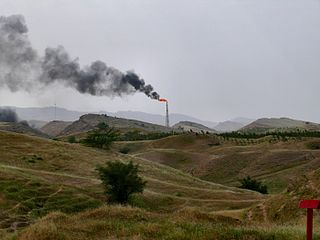Related Research Articles

Deforestation or forest clearance is the removal of a forest or stand of trees from land that is then converted to non-forest use. Deforestation can involve conversion of forest land to farms, ranches, or urban use. The most concentrated deforestation occurs in tropical rainforests. About 31% of Earth's land surface is covered by forests at present. This is one-third less than the forest cover before the expansion of agriculture, with half of that loss occurring in the last century. Between 15 million to 18 million hectares of forest, an area the size of Bangladesh, are destroyed every year. On average 2,400 trees are cut down each minute.

Environmental issues in Mali include desertification, deforestation, soil erosion, drought, and inadequate supplies of potable water. Deforestation is an especially serious and growing problem. According to the Ministry of the Environment, Mali’s population consumes 6 million tons of wood per year for timber and fuel. To meet this demand, 4,000 square kilometers of tree cover are lost annually, virtually ensuring destruction of the country’s savanna woodlands.

Environmentally, Colombia is a mega-diverse country from its natural land terrain to its biological wildlife. Its biodiversity is a result of its geographical location and elevation. It is the fourth largest South American country and only country in South America to have coasts on the Pacific and Caribbean Sea. Colombia's terrain can be divided into six main natural zones: The Caribbean, the Pacific, The Orinoco region, The Amazonia region, the Andean region, and the Insular region. 52.2% of the environment is predominately the Andes, Amazon, and Pacific Basins, followed by the Orinoco basin 13.9%, the Andes and the Caribbean. The Tropical Andes, Choco, and the Caribbean are considered biodiversity hotspots which puts these areas at high risk of concentration of colonizing activities. Colombia host over 1800 bird species and at least one new species are detected every year. Decades of civil war and political unrest have impeded biological and environmental research in Colombia. The political unrest in Colombia catalyzes the alteration of land patterns through the cultivation of coca and opium crops, the redirection of extractive activities, and land abandonment in some areas.
As in many neighboring countries, most environmental issues in Ethiopia relate to deforestation and endangered species.

Environmental issues in Venezuela include natural factors such as earthquakes, floods, rockslides, mudslides, and periodic droughts.

Environmental issues in Iran include, especially in urban areas, vehicle emissions, refinery operations, and industrial effluents which contribute to poor air quality. A report by the United Nations Environment Programme ranked Iran at 117th place among 133 countries in terms of environmental indexes. Water scarcity is a serious issue, and the country is also threatened by climate change.

Environmental issues in Nepal include a number of issues, such as deforestation, climate change, energy and species conservation. Many of these issues have been precipitated by rapid industrialization without major environmental regulation.
Like most former republics of the Soviet Union, Azerbaijan experienced rapid economic development which has led to an increasingly negative impact on the environment, including the inefficient usage of natural resources. The government of Azerbaijan has aimed to increase environmental protection and ensure rational utilization of natural resources, and has introduced a number of important laws, legal documents and state programs in order to improve the ecological situation in the country. However, these precautionary laws have not been as effective as they were meant to be. Transparency has been a consistent issue in Azerbaijan, as NGOs who are given legal authority to collect data from the oil refineries are often blocked or dismissed, and their information is gathered unofficially. Domestic oil producers have often evaded the regulations, and have not prevented oil leaks into the Caspian Sea. In the next 30 years, Azerbaijan will produce more oil than it produced during the 20th century, and currently there is little coordination or environmental precaution in the oil drilling operations. There is also a lack of communication with neighboring countries bordering the Caspian Sea.
The flora of Belize is highly diverse by regional standards, given the country's small geographical extent. Situated on the Caribbean coast of northern Central America the flora and vegetation have been intimately intertwined with Belize's history. The nation itself grew out of British timber extraction activities from the 17th century onwards, at first for logwood and later for mahogany, fondly called "red gold" because of its high cost and was much sought after by European aristocracy. Central America generally is thought to have gained much of it characteristic flora during the "Great American interchange" during which time South American elements migrated north after the geological closure of the isthmus of Panama. Few Amazonian elements penetrate as far north as Belize and in species composition the forests of Belize are most similar to the forests of the Petén (Guatemala) and the Yucatán (Mexico).

The environment of Côte d'Ivoire has more than 1,200 animal species—223 mammal, 702 bird, 125 reptile, 38 amphibian, and 111 fish species—and 4,700 plant species. It is the most biodiverse country in West Africa, but unlike other countries there, its diversity isn't concentrated along the coast, but rather in the rugged interior. However, much like the rest of West Africa, Côte d'Ivoire has suffered severe deforestation.

Malaysia faces several environmental issues. Malaysia's environment possesses megadiverse biological diversity, with globally significant endemism and biodiversity, but is threatened by several issues. Deforestation is a major issue in the country that has led to many species becoming threatened with extinction. As a major economic sector, palm oil production has had a substantial environmental impact. Air pollution is also a major issue, with the country one of the most affected countries by seasonal Southeast Asian haze. The country is also affected by climate change.
Like other island nations, Antigua and Barbuda faces unique environmental issues created by its proximity to the ocean, and small size. These include pressures on water resources, natural ecosystems, and deforestation more generally.
The principal environmental issues in Peru are water pollution, soil erosion, pollution and deforestation. Although these issues are problematic and equally destructive, the Peruvian Environmental ministry has been developing regulation and laws to decrease the amount of pollution created in major cities and have been making policies in order to decrease the present deforestation rate in Peru.
Cuba possesses a diverse range of natural habitats, housing a wide variety of species, including many endangered ones. However, the country has faced environmental challenges, particularly deforestation, since the arrival of European settlers. Forest areas have been cleared for agricultural purposes, leading to the loss of forests and the extinction of certain species. The cutting down of trees for fuel and construction materials has further contributed to this issue.
There are a number of known environmental issues in the post-communist country of Albania. Issues include air and water pollution, poor waste management infrastructure and deforestation. The Albanian environmental movement includes around 40 active non-government organisations.

Environmental issues in Serbia include air pollution, deforestation, various categories of threat to endemic species and climate changes. Several environmental organizations operating in Serbia have protested the government's handling of these issues.

The environment of North Korea comprises the diverse ecosystems of the part of the Korean peninsula controlled by the Democratic People's Republic of Korea. This includes alpine, forest, farmland, freshwater, and marine ecosystems.

There are many pressing environmental issues in Mongolia that are detrimental to both human and environmental wellness. These problems have arisen in part due to natural factors, but increasingly because of human actions. One of these issues is climate change, which will be responsible for an increase in desertification, natural disasters, and land degradation. Another is deforestation, which is expanding due to human recklessness, pests, disease, and fires. Mongolian lands are becoming more arid through desertification, a process that is being exacerbated due to irresponsible land use. Additionally, more and more species are disappearing and at risk for extinction. Moreover, especially in population centers, Mongolians deal with air and water pollution caused by industrialization.
Laos is increasingly suffering from environmental problems, with deforestation a particularly significant issue, as expanding commercial exploitation of the forests, plans for additional hydroelectric facilities, foreign demand for wild animals and nonwood forest products for food and traditional medicines, and a growing population all create increasing pressure.
Senegal's environmental issues are varied. According to the CIA world factbook pressing problems exist with: diminishing wildlife populations which are threatened by poaching, deforestation, overgrazing, soil erosion, desertification, and overfishing.
References
- ↑ "Paraguay", Monga Bay. Retrieved October 12, 2017
- ↑ Grantham, H. S.; Duncan, A.; Evans, T. D.; Jones, K. R.; Beyer, H. L.; Schuster, R.; Walston, J.; Ray, J. C.; Robinson, J. G.; Callow, M.; Clements, T.; Costa, H. M.; DeGemmis, A.; Elsen, P. R.; Ervin, J.; Franco, P.; Goldman, E.; Goetz, S.; Hansen, A.; Hofsvang, E.; Jantz, P.; Jupiter, S.; Kang, A.; Langhammer, P.; Laurance, W. F.; Lieberman, S.; Linkie, M.; Malhi, Y.; Maxwell, S.; Mendez, M.; Mittermeier, R.; Murray, N. J.; Possingham, H.; Radachowsky, J.; Saatchi, S.; Samper, C.; Silverman, J.; Shapiro, A.; Strassburg, B.; Stevens, T.; Stokes, E.; Taylor, R.; Tear, T.; Tizard, R.; Venter, O.; Visconti, P.; Wang, S.; Watson, J. E. M. (2020). "Anthropogenic modification of forests means only 40% of remaining forests have high ecosystem integrity - Supplementary Material". Nature Communications. 11 (1). doi: 10.1038/s41467-020-19493-3 . ISSN 2041-1723. PMC 7723057 .
![]() This article incorporates text from this source, which is in the public domain . Country Studies. Federal Research Division.
This article incorporates text from this source, which is in the public domain . Country Studies. Federal Research Division.
